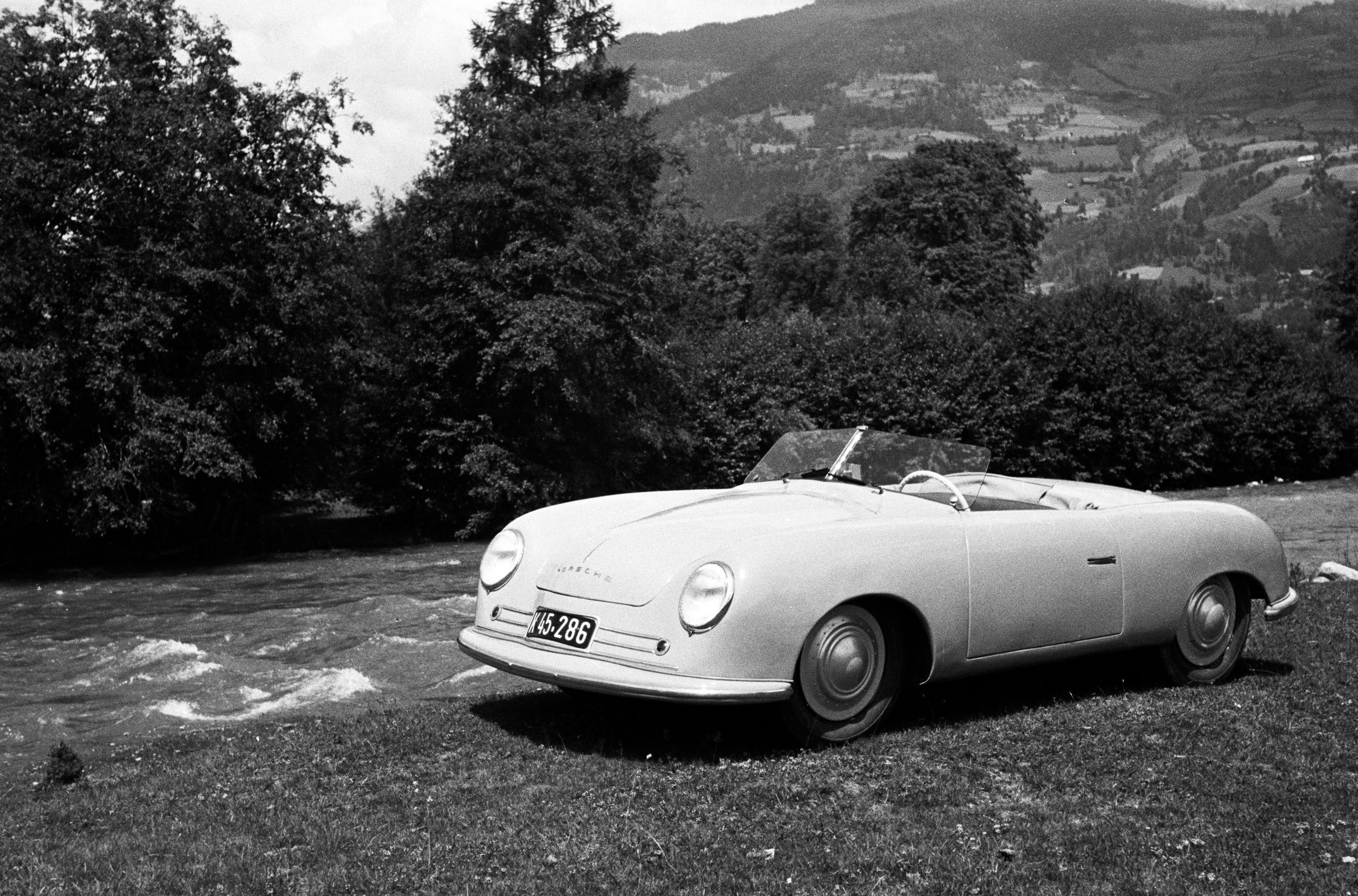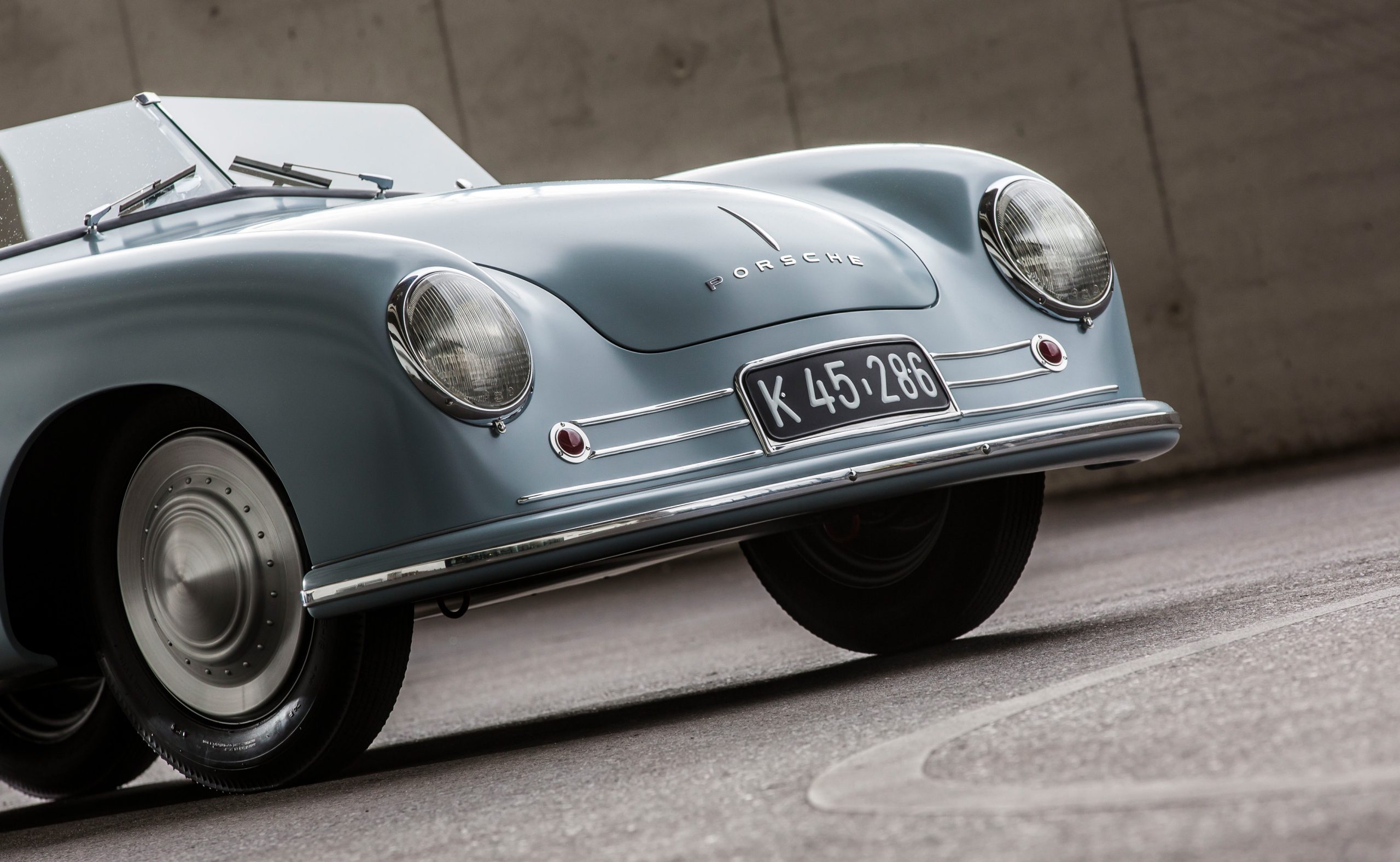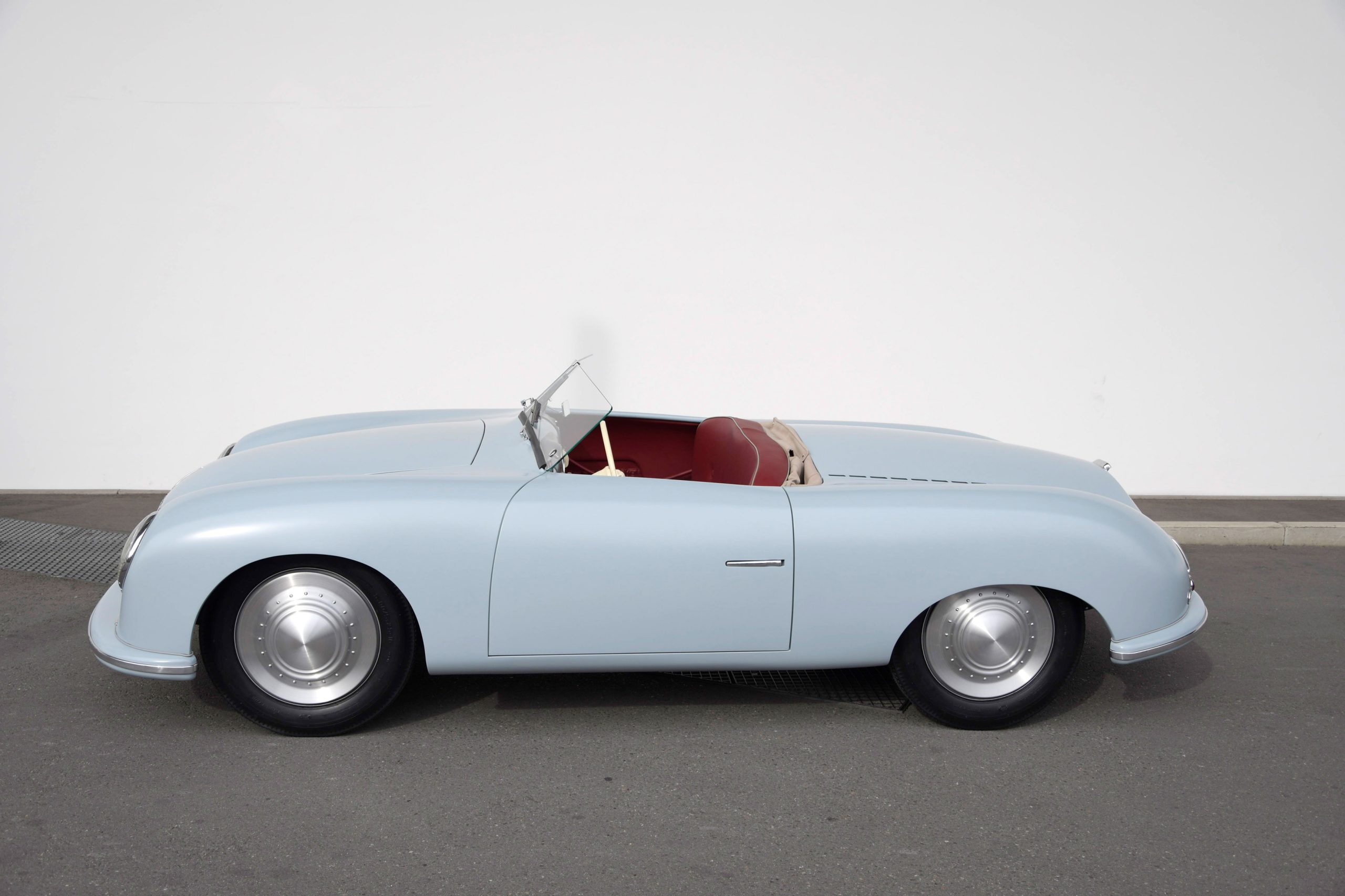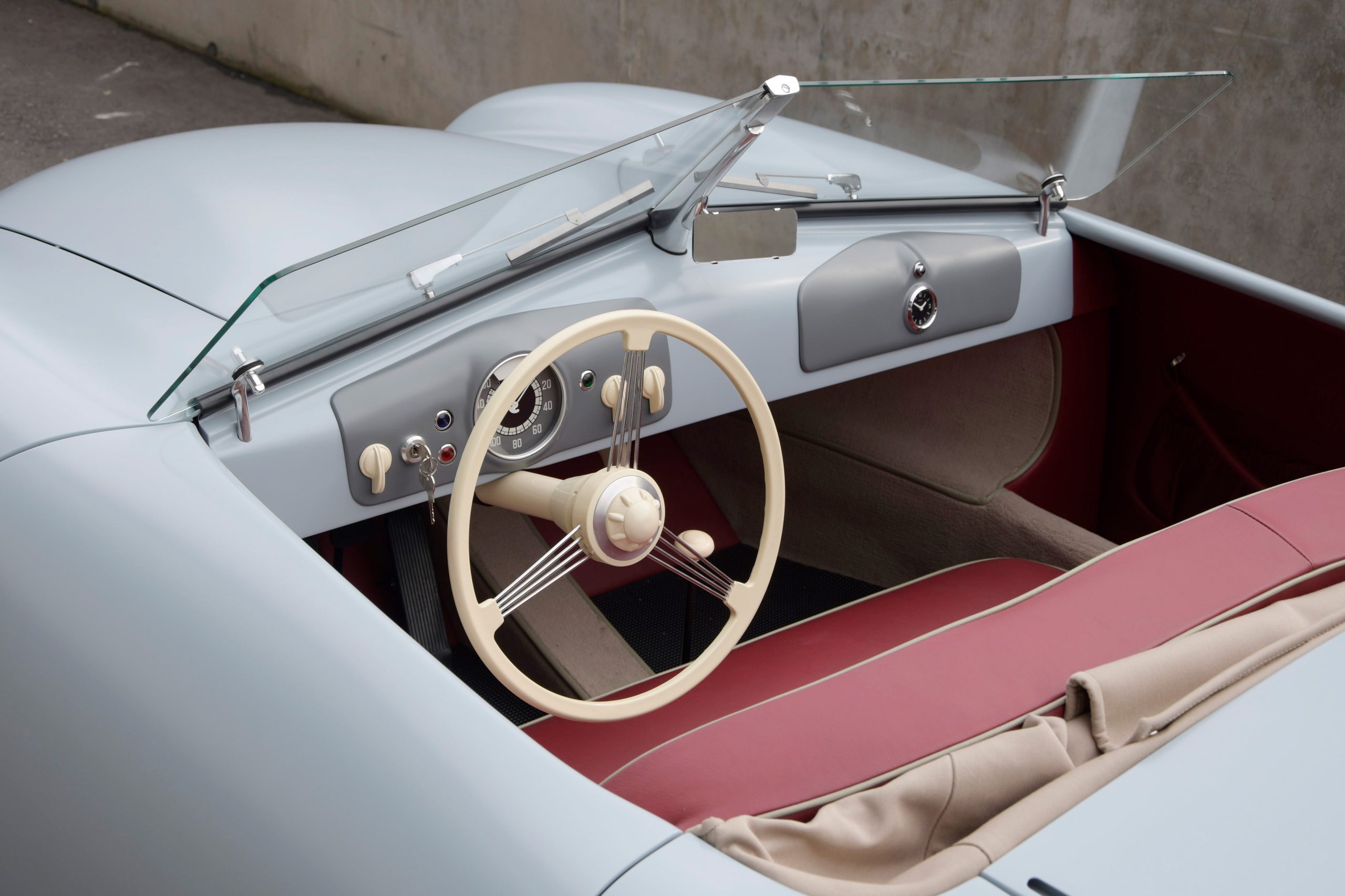1948 Porsche 356/1 – The Ultimate Guide
The first Porsche, chasssis 356-001, was produced in Gmünd as two-seat roadster using VW parts. Work on the project started as early as 1947 and was authorized by Ferry Porsche to begin construction in March of 1958 of the new Sportwagen Typ 356. He was undoubtedly influenced by Cisitalia which was making cars based on Porsche designs from basic Fiat components.1
With Volkswagen production beginning as early as 1945, Porsche had a steady supply of Volkswagen parts to rely on. Porsche designers drew up a new tubular space frame with the VW engine placed behind the driver and in front of the rear axle much like the pre-war Auto Unions. Using a reversed VW swing-arm suspension, the setup was unfavorable since the trailing-turned-leading arms were held in place using the torsion bars which ran rearward of the car and required a longer chassis than normal.1
The steering, brakes, suspension, transmission, clutch and headlights were all sourced from Volkswagen. The 25 bhp engine was bored, fitted with larger valves and fitted with a higher-compression cylinder head to produce 35-40 bhp.
The prototype, called the first Porsche by many and known as Porsche No. 1 was completed in March on 1948 in Austria. It was tested in chassis form before Erwin Komenda designed the bodywork. Details such as pop-out door handles, integrated bumpers and a decorative aluminum license plate surround separated the car from its VW roots. Inside Komenda fitted a bench seat, spartan controls and minimal upholstery.
Upon completion the car was previewed in Swiss Grand Prix and then used to win a local race in Austria called Rund um den Hofgarten.
By 1950, the first 356 model went into series production in Stuttgart. The model was available in the Coupé, Speedster and Convertible variants. At some point the car was modified with a new floor and bucket seats. It is currently the centerpiece of Porsche’s own collection and is a permanent fixture in their museum.
Porsche’s Take on the 356 ‘No. 1’ Roadster
The 356 ‘No. 1’ Roadster has a colourful past. The first ever Porsche to be produced was one of a kind and not only changed owners several times in its first ten years, but also took some punishment along the way, and was repaired and converted too.
Ferry Porsche’s dream of creating his own sports car started to become a reality in summer 1947 under the project number 356.49.001. The dimensional drawing from 6 January 1948 shows a mid-engine two-seat roadster with a tubular frame – an underlying concept taken from racing car designs. Aside from the body, the components for the engine, gearbox and chassis largely came from Volkswagen and were specifically modified for the Porsche design. A roadworthy chassis had been completed by February 1948 and a sleek roadster body made of aluminium was produced for this shortly afterwards.
On 8 June 1948, the prototype bearing the chassis number 356-001 was granted a general operating permit by the Carinthian state government. This date has since been considered the birth of the Porsche brand, as it marked the first time that an innovation developed by this renowned engineering office also bore the family name. The performance figures soon caught the attention of sports car enthusiasts: the four-cylinder boxer engine taken from a Volkswagen was upgraded from 18 kilowatts (24.5 horsepower) to 26 kilowatts (35 horsepower), while the car achieved a kerb weight of 585 kilograms. This made it easy for the roadster to match the driving performance of considerably more powerful rivals.
As the fledgling company needed money to build more cars, Porsche sold the prototype to the entrepreneur Rupprecht von Senger for 7,000 Swiss francs on the day it was granted approval. The 356 ‘No. 1’ Roadster then changed hands several times and was repaired following a collision, with the front and rear section being adapted in line with the production version of the Porsche 356 at the owner’s request. This resulted in a number of changes, such as a lower front and the installation of a two-piece rear cover in place of the original single-piece solution. The prototype was also given a 1.5-litre engine and hydraulic brakes in 1952. Richard von Frankenberg, a racing driver and chief editor of the customer magazine ‘Christophorus’, then exchanged the 356 ‘No. 1’ Roadster for a 356 Speedster in 1958.
This made Porsche one of the very few car companies in the world to still have the first-ever car to bear the brand’s name. As an original with its own special story, the 356 ‘No. 1’ Roadster was not returned to its initial state but allowed to remain with all its adjustments and modifications intact – in honour of the many different phases of this historic model.
Then as now, the first Porsche ever built is still fully functional. As part of a 2018 world tour to mark its anniversary, it will not only be on show at a range of events but will also be taking part in various historic races such as the Goodwood Festival of Speed and the Porsche Rennsport Reunion.
Source: Porsche website
356 ‘No. 1’ Roadster Pictures







356 ‘No. 1’ Show Car
When the 356 ‘No. 1’ Roadster was granted its operating permit on 8 June 1948, it looked very different to how it does today. Porsche has now created a show car to bring the original design of the brand’s first ever sports car back to life.
The 356 ‘No. 1’ Roadster is a piece of living history. By the time the original returned to Porsche in 1958, a number of modifications had already been made to the car: having changed hands several times over the course of ten years, it had witnessed technical upgrades including a more powerful engine and improved brakes. However, the most significant alterations had been made to the body – as part of accident repairs, this had been given a more cutting-edge look matching that of the later 356 production cars. In order to preserve the history of the first Porsche sports car and bring the original design of the roadster back to life, the Porsche Museum has constructed a show car featuring the body design of the 1948 model.
The experts at the Porsche Museum began by using digitised measurement data to compare the original design drawings with the original roadster in its current condition down to the last millimetre. All available photographs and descriptions held by the Historical Archive and dating from the period in which the 356 ‘No. 1’ Roadster came into being were assessed, with this data pool enabling the creation of a model that brought to light considerable differences in design. One typical example was the rear cover, which was originally a single-piece solution that featured an indent towards the back and extended from the passenger cabin almost up to the rear bumper.
When the original car underwent repairs following an accident, this single-piece cover was replaced with a two-piece version featuring a lateral sheet above the engine and a shorter lid above the rear luggage compartment. In the original 1948 design, the body was also narrower towards the back and the front had a much sharper swept appearance with a well-defined nose.
Computer-milled wooden models were used to help recreate the original 356 ‘No. 1’ Roadster body, which was made by hand from aluminium sheets as it had been 70 years ago. Like in 1948, the sheets were bent, pulled and forced using manual tools – fully in keeping with the maxim of the Porsche Museum that each and every restoration and replica must be as authentic as possible. These original details can even be found in the formula for the paint. To get the colour just right, layer samples were taken from the original model in the Porsche Museum – which had been given many different coats of paint over the years – and these were analysed to find an exact match. Modern instruments featuring dials that have been adapted precisely to the original flank the wheel and even the weaving of the carpets corresponds to the practice from 70 years ago.
From the perspective of Porsche, the show car is an important development in both historical and highly symbolic terms as its appearance, its driving dynamics and its lightweight design represent the very core of all sports cars bearing the Porsche brand. The replica will be on display in a special exhibition at Porsche Drive in Berlin from March to May 2018 and will then embark on a world tour. Scheduled stops include the Porsche Museum in Zuffenhausen and events in far-flung locations such as South Africa and China.
Source: Porsche website
356 ‘No. 1’ Show Car Pictures

















